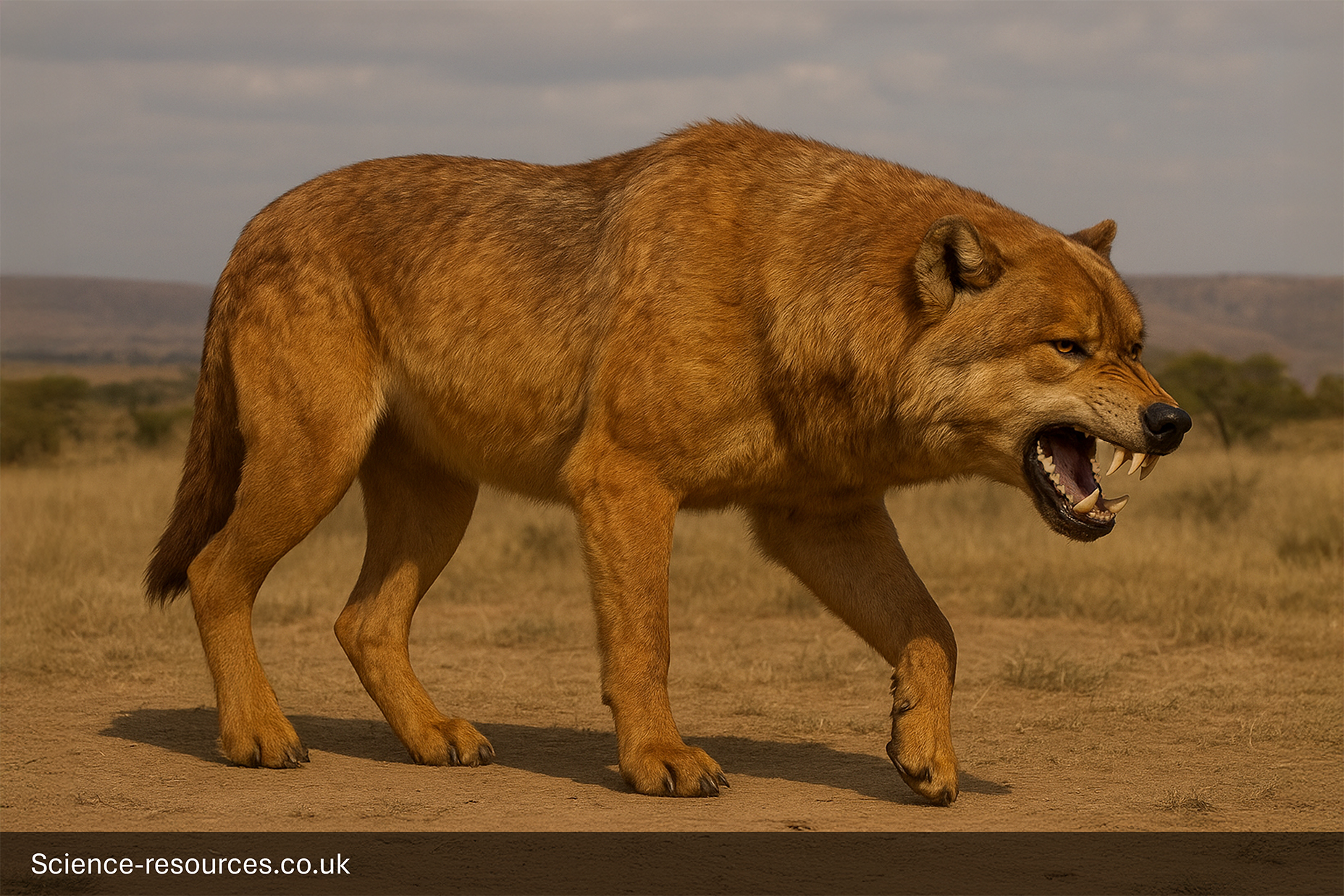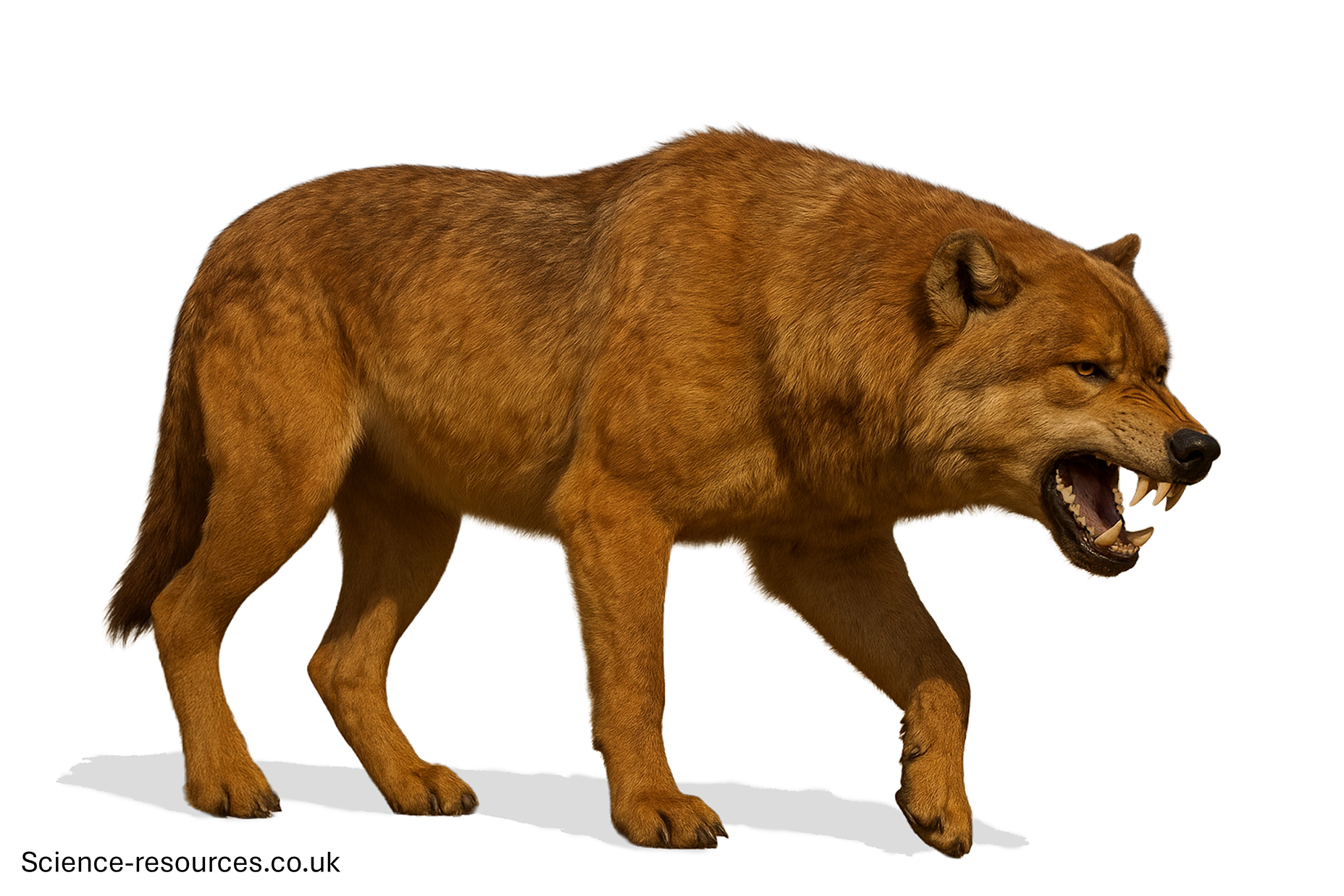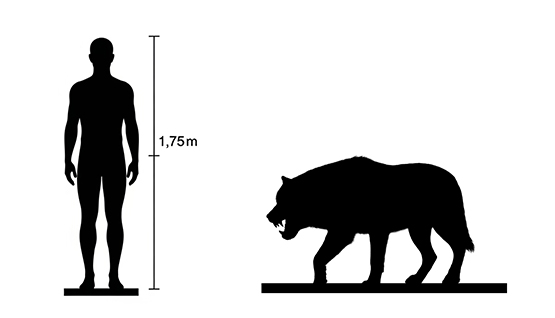Last updated: 4th August 2025
Extinct Animals: Dire Wolf
Dire wolf, an extinct prehistoric predator, most famous for its powerful build and bone-crushing jaws.
Dire Wolf (Aenocyon dirus)
 Dire wolf
Dire wolf
Generative AI Notification: Some elements of this image have been created or enhanced using AI technology. To find out how we create all our prehistoric animals, click here.
What is a dire wolf?
The Dire Wolf was a large, prehistoric relative of today’s wolves. It lived during the Late Pleistocene epoch (Ice Age) across North and South America. Fierce and powerful, dire wolves roamed the grasslands and forests hunting in packs.
How big was dire wolf?
Dire wolves were bigger and heavier than modern grey wolves. They measured up to 1.5 metres (5 feet) in length and stood about 80 centimetres (2.6 feet) tall at the shoulder. Adults could weigh as much as 68 kilograms (150 pounds).
What did dire wolf eat?
Dire wolves were carnivores. They hunted large prey such as bison, horses, and even young mammoths. Their strong jaws and large teeth helped them crush bones and feast on meat.
Dire wolf appearance
Dire wolves looked similar to modern wolves but were stockier with a larger head and shorter legs. They had thick fur and a powerful build, ideal for tackling big prey and surviving cold climates.
 Dire wolf appearance
Dire wolf appearance
Where did dire wolves live?
Fossils have been found throughout North America, especially in places like the La Brea Tar Pits in California, USA. Some remains have also been discovered in South America.
Interesting facts
- Dire wolves are not direct ancestors of today’s wolves. They belonged to a different genus and split from modern wolves millions of years ago.
- Dire wolf packs may have worked together to bring down huge Ice Age animals.
- DNA studies show dire wolves were genetically distinct from both grey wolves and domestic dogs.

Dire wolf Facts
Pronounced: DY-er wolf
Name Means: “Fearsome Wolf” (from Latin dirus, meaning “fearful” or “ominous”)
Length: Up to 1.5 metres (5 feet)
Height: Around 80 centimetres (2.6 feet) at shoulder
Weight: Up to 68 kilograms (150 pounds)
Diet: Carnivore (Meat)
Time: Late Pleistocene Epoch (about 250,000 to 13,000 years ago)
Fossils Found: North and South America (especially USA, Mexico, Venezuela)
Which family of animals did dire wolves belong to?
The dire wolf belonged to the family Canidae, which includes dogs, wolves, foxes, and jackals. It was a member of the genus Canis, but recent DNA research shows it was a unique branch of the dog family tree.
What other animals lived at the same time as dire wolves?
Dire wolves shared their world with giant ground sloths, sabre-tooth cats (like Smilodon), mammoths, American lions, and early humans during the last Ice Age.
Dire wolf FAQ
Q1: What was a Dire wolf?
The Dire Wolf (Canis dirus) was a large, extinct member of the dog family that lived during the Ice Age in the Americas.
Q2: What did Dire Wolves look like?
A2: They looked similar to today’s grey wolves but were larger, heavier, and had a broader skull and more powerful jaws.
Q3: How big was the Dire Wolf?
A3: It could reach up to 1.5 metres (5 feet) long, 80 cm (2.6 feet) tall at the shoulder, and weigh up to 68 kg (150 lbs).
Q4: What did Dire Wolves eat?
A4: Carnivorous, they hunted large prey such as bison, horses, and mastodons, and also scavenged when necessary.
Q5: Where did Dire Wolves live?
A5: Their fossils are found throughout North and South America, especially in the United States, Mexico, and Venezuela.
Q6: When did Dire Wolves go extinct?
A6: Dire Wolves disappeared around 13,000 years ago, likely due to climate change and the decline of their prey at the end of the Ice Age.
Q7: Did Dire Wolves hunt in packs?
A7: Scientists believe they hunted in groups, much like modern wolves, to tackle large prey and compete with other predators.
Q8: How are Dire Wolves related to modern animals?
A8: While part of the dog family, DNA studies show Dire Wolves were only distantly related to today’s wolves, dogs, and coyotes.
Q9: Who discovered the Dire Wolf?
A9: The first Dire Wolf fossils were described in 1858 by Joseph Leidy, an American palaeontologist.
Q10: Are there any complete skeletons of Dire Wolves?
A10: Yes, many well-preserved bones and even nearly complete skeletons have been found, especially at the La Brea Tar Pits in California.
You may also be intrested in:
- Extinct Animals: A-Z
- Dinosaurs: A-Z
Tags: How big was dire wolf, Dire wolf size, where did dire wolves live, how tall was wire wolf, what does dire wolf mean, Dire wolf facts
Previous: Daeodon
Up next: Doedicurus
© 2012 science-resources.co.uk. All rights reserved | Design by W3layouts
Extinct Animals: Dire Wolf
Dire wolf, an extinct prehistoric predator, most famous for its powerful build and bone-crushing jaws.
Dire Wolf (Aenocyon dirus)
 Dire wolf
Dire wolf
Generative AI Notification: Some elements of this image have been created or enhanced using AI technology. To find out how we create all our prehistoric animals, click here.
What is a dire wolf?
The Dire Wolf was a large, prehistoric relative of today’s wolves. It lived during the Late Pleistocene epoch (Ice Age) across North and South America. Fierce and powerful, dire wolves roamed the grasslands and forests hunting in packs.
How big was dire wolf?
Dire wolves were bigger and heavier than modern grey wolves. They measured up to 1.5 metres (5 feet) in length and stood about 80 centimetres (2.6 feet) tall at the shoulder. Adults could weigh as much as 68 kilograms (150 pounds).
What did dire wolf eat?
Dire wolves were carnivores. They hunted large prey such as bison, horses, and even young mammoths. Their strong jaws and large teeth helped them crush bones and feast on meat.
Dire wolf appearance
Dire wolves looked similar to modern wolves but were stockier with a larger head and shorter legs. They had thick fur and a powerful build, ideal for tackling big prey and surviving cold climates.
 Dire wolf appearance
Dire wolf appearance
Where did dire wolves live?
Fossils have been found throughout North America, especially in places like the La Brea Tar Pits in California, USA. Some remains have also been discovered in South America.
Interesting facts
- Dire wolves are not direct ancestors of today’s wolves. They belonged to a different genus and split from modern wolves millions of years ago.
- Dire wolf packs may have worked together to bring down huge Ice Age animals.
- DNA studies show dire wolves were genetically distinct from both grey wolves and domestic dogs.

Dire wolf Facts
Pronounced: DY-er wolf
Name Means: “Fearsome Wolf” (from Latin dirus, meaning “fearful” or “ominous”)
Length: Up to 1.5 metres (5 feet)
Height: Around 80 centimetres (2.6 feet) at shoulder
Weight: Up to 68 kilograms (150 pounds)
Diet: Carnivore (Meat)
Time: Late Pleistocene Epoch (about 250,000 to 13,000 years ago)
Fossils Found: North and South America (especially USA, Mexico, Venezuela)
Which family of animals did dire wolves belong to?
The dire wolf belonged to the family Canidae, which includes dogs, wolves, foxes, and jackals. It was a member of the genus Canis, but recent DNA research shows it was a unique branch of the dog family tree.
What other animals lived at the same time as dire wolves?
Dire wolves shared their world with giant ground sloths, sabre-tooth cats (like Smilodon), mammoths, American lions, and early humans during the last Ice Age.
Dire wolf FAQ
Q1: What was a Dire wolf?
The Dire Wolf (Canis dirus) was a large, extinct member of the dog family that lived during the Ice Age in the Americas.
Q2: What did Dire Wolves look like?
A2: They looked similar to today’s grey wolves but were larger, heavier, and had a broader skull and more powerful jaws.
Q3: How big was the Dire Wolf?
A3: It could reach up to 1.5 metres (5 feet) long, 80 cm (2.6 feet) tall at the shoulder, and weigh up to 68 kg (150 lbs).
Q4: What did Dire Wolves eat?
A4: Carnivorous, they hunted large prey such as bison, horses, and mastodons, and also scavenged when necessary.
Q5: Where did Dire Wolves live?
A5: Their fossils are found throughout North and South America, especially in the United States, Mexico, and Venezuela.
Q6: When did Dire Wolves go extinct?
A6: Dire Wolves disappeared around 13,000 years ago, likely due to climate change and the decline of their prey at the end of the Ice Age.
Q7: Did Dire Wolves hunt in packs?
A7: Scientists believe they hunted in groups, much like modern wolves, to tackle large prey and compete with other predators.
Q8: How are Dire Wolves related to modern animals?
A8: While part of the dog family, DNA studies show Dire Wolves were only distantly related to today’s wolves, dogs, and coyotes.
Q9: Who discovered the Dire Wolf?
A9: The first Dire Wolf fossils were described in 1858 by Joseph Leidy, an American palaeontologist.
Q10: Are there any complete skeletons of Dire Wolves?
A10: Yes, many well-preserved bones and even nearly complete skeletons have been found, especially at the La Brea Tar Pits in California.
Tags: How big was dire wolf, Dire wolf size, where did dire wolves live, how tall was wire wolf, what does dire wolf mean, Dire wolf facts
Previous: Daeodon
Up next: Doedicurus
© 2012 science-resources.co.uk. All rights reserved | Design by W3layouts